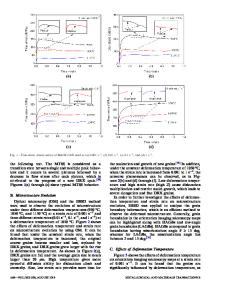An In-situ Electron Microscopy Study of Microstructural Evolution in a Co- NbCo 2 Binary Alloy
- PDF / 3,219,952 Bytes
- 6 Pages / 612 x 792 pts (letter) Page_size
- 90 Downloads / 295 Views
1128-U08-09
An In-situ Electron Microscopy Study of Microstructural Evolution in a Co- NbCo2 Binary Alloy Sharvan Kumar1, Padam Jain1, Seong Woong Kim1, Frank Stein2 and Martin Palm2 1. Division of Engineering, Brown University, 182 Hope Street, Providence 02912, RI, USA. 2. Max-Planck Institut für Eisenforschung GmbH, Max-Planck-Str. 1, D-40237 Düsseldorf, Germany.
ABSTRACT The microstructure in a Co-rich, Co-15 at.% Nb alloy was characterized in the as-cast condition. A predominantly lamellar eutectic morphology composed of a Co-Nb solid solution and the C15 Laves phase NbCo2 was confirmed by transmission electron microscopy. The C15 phase was heavily twinned, with only one variant of twins being present in the individual lamella, while the Co solid solution had the face centered cubic structure. In-situ heating to 600°C in the microscope confirmed the decomposition of the metastable Laves phase into a fine equiaxed, ~10-20 nm grain size microstructure, and the product phase is the monoclinic Nb2Co7. The individual grains appear faulted. The matrix solid solution retained the fcc structure and no change in structure was observed on cooling to room temperature. Heating to temperatures as high as 1130°C leads to rapid grain growth in the Nb2Co7 phase, and the nucleation and growth of a few new grains within the original grains; however, the reverse peritectoid transformation previously reported, was not observed. INTRODUCTION Laves phases of refractory metals have been of interest for high temperature applications [1,2] and the Co-Nb binary system has received recent attention [3-5]. The Co-Nb binary phase diagram has been re-assessed and a revised phase diagram was recently published [3] and is reproduced in Figure 1. Noteworthy and relevant to this paper are i) the presence of a C15 Laves phase (NbCo2) over a range of compositions and congruently melting at 1484°C, (ii) a peritectic reaction between this Laves phase and a more Co-rich liquid to form a highly defective Co-rich C36 Laves phase at 1264°C (see [4] for crystallographic details of this defect C36 structure), (iii) a eutectic decomposition of liquid of composition Co-13.9 at.% Nb into fcc Co solid solution and the C36 phase at 1239°C, and (iv) a peritectoid reaction at 1086°C between the C36 phase and Co solid solution to produce the monoclinic phase Nb2Co7. An alloy such as Co15 at.% Nb (shown by the dashed line in Figure 1) should, under equilibrium freezing conditions, then form a small amount of the C15 phase initially, that at 1264°C should react with the liquid peritectically to form the C36 phase, while the rest of the liquid at 1239°C should decompose eutectically to form the Co solid solution phase and the C36 phase. Subsequently, at room temperature, the microstructure should be composed of the two phases, Co solid solution and Nb2Co7. Since peritectic and even more so, peritectoid reactions, are notoriously sluggish, it is unlikely that such a microstructure would result under practical solidification conditions. In such a case, the decompos
Data Loading...











